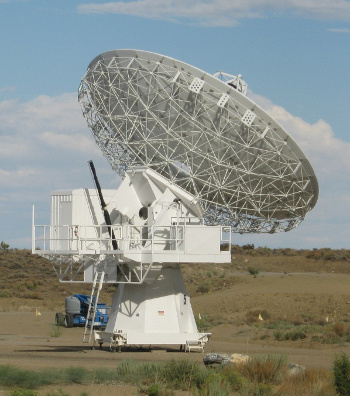| Tikalon Blog is now in archive mode.
An easily printed and saved version of this article, and a link
to a directory of all articles, can be found below: |
|
This article |
| Directory of all articles |
Don Backer
August 5, 2010
Plainfield, New Jersey, is about a forty minute's drive from my home.
Holmdel, New Jersey, is about the same distance from Plainfield. Holmdel is where
Karl Jansky discovered the first extraterrestrial radio signals using a steerable antenna tuned for 20.5 MHz.[1-2] He was looking for the sources of radio static, something that interested his employer,
Bell Laboratories. What he discovered was the intense radio source,
Sagittarius A, located at the center of our galaxy. Holmdel is also the place where
Arno Penzias and
Robert Wilson discovered, also by accident, the
cosmic microwave background radiation. They thought the source of their noise was pigeon droppings.[3]
Don Backer was born in Plainfield about a decade after Jansky's discovery, and he was just finishing his undergraduate education in 1965 when Penzias and Wilson made their discovery. Perhaps the proximity of Plainfield to the origins of radio astronomy influenced Don Backer's decision to pursue radio astronomy as a career.
Donald C. Backer, a preeminent radio astronomer, died unexpectedly on July 25, 2010.[4-6]

February, 1932, discovery trace of extraterrestrial radio signals by Karl Jansky. See ref. 1-2 for details.
After earning his BS in engineering physics at
Cornell University in 1966, Backer received an MS in radio astronomy from
Manchester University, home of the
Jodrell Bank Observatory; and then a PhD in astronomy from Cornell in 1971. PhDs in radio astronomy have a limited palette of potential employers, so Backer took a post-doctoral position at some of the usual venues - The
National Radio Astronomy Observatory,
Charlottesville, Virginia, and
NASA's Goddard Space Flight Center,
Greenbelt, Maryland. Backer accepted a research position at the
University of California, Berkeley, eventually becoming a professor of astronomy there in 1989, and director of its Radio Astronomy Laboratory. This includes the
Allen Telescope Array,
Hat Creek, California, designed to search for radio signals from extraterrestrials (
SETI).
Backer's most enduring claim to fame is the discovery of the first millisecond
pulsar,
PSR B1937+21, a neutron star about the size of the Earth that rotates nearly 642 times a second. He utilized pulsars in other research in attempts to detect
gravitational radiation through precise observations of the frequencies of pulsars along different lines of sight. Pulsar timekeeping is as good at that of
atomic clocks, so they are useful as sensitive detectors of gravitational radiation. Their frequencies are detected by the
Pulsar Timing Array, the goal of which is the detection of very low frequency gravitational radiation (micro-Hertz range). Utilizing his engineering physics background, Backer invented digital systems for precise measurements of pulsars.

CARMA dish, one of many used in VLBI arrays. (Photograph by Palmtree3000)
Another of Backer's accomplishments, and something easier for laymen to appreciate, are the high-resolution radio images he facilitated through the use of
Very Long Baseline Interferometry (VLBI). Linking the Berkeley 85-foot radio telescope with other radio telescopes throughout the world allowed radio imaging of the region at the center of our galaxy that harbors a black hole.
Dan Werthimer, a former student of Backer's and chief scientist of
SETI@home, had this remembrance of Backer [4]
"Don was constantly challenging himself and his students, switching fields dramatically throughout his career, from pulsars to gravity waves, to the galactic center, and then to the origin of structure in the universe. Don made pioneering contributions to each of these fields, but he didn't let it go to his head, and he always maintained his characteristic kind and gentle manner."
References:
- C. M. Jansky, Jr., "My Brother Karl Jansky and His Discovery of Radio Waves from Beyond the Earth." March 23, 1956 (Reprinted in Cosmic Search, vol. 1, no. 4).
- "Karl Jansky and the Discovery of Cosmic Radio Waves," National Radio Astronomy Observatory, May 16, 2008.
- Arno Allan Penzias page on Wikipedia.
- "World-renowned astronomer Donald C. Backer dies at age 66," UC Berkeley press release (July 29, 2010).
- Adam Mann, Nature Blogs, "Don Backer, astrophysicist and discoverer of millisecond pulsars, dies at 66 - July 27, 2010," July 27, 2010.
- David Perlman, "UC Berkeley astronomer Don Backer dies," San Francisco Chronicle, July 31, 2010.
- Don Backer page at UC Berkeley.
- Don Backer's Home Page.
- Don Backer's CV (PDF File).
- ATA Survey - Don Backer and Jill Tarter (SETI Talks) on YouTube.
Permanent Link to this article
Linked Keywords: Karl Jansky; Bell Laboratories; Sagittarius A; Arno Penzias; Robert Wilson; cosmic microwave background radiation; Donald C. Backer; Cornell University; Manchester University; Jodrell Bank Observatory; National Radio Astronomy Observatory; Charlottesville, Virginia; NASA's Goddard Space Flight Center; Greenbelt, Maryland; Allen Telescope Array; Hat Creek, California; SETI; pulsar; PSR B1937+21; gravitational radiation; atomic clocks;CARMA array; Very Long Baseline Interferometry; Dan Werthimer; SETI@home;